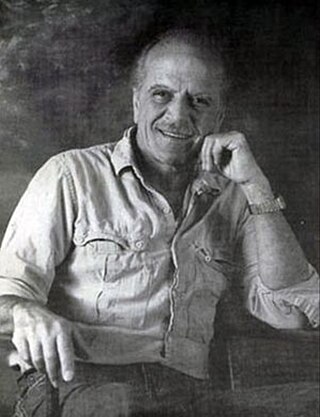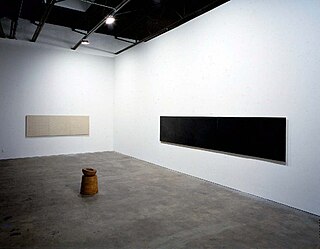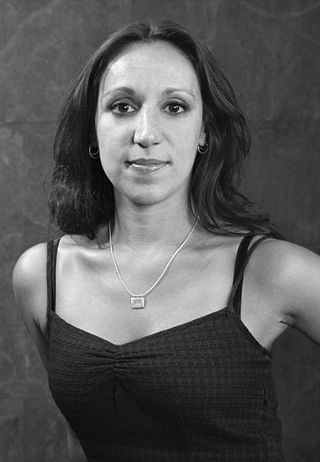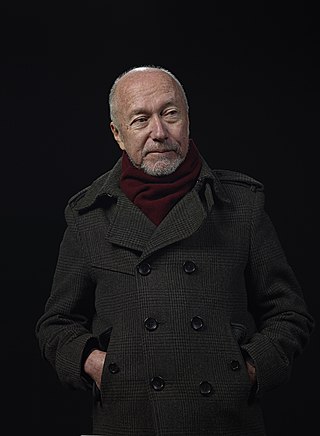Related Research Articles

Rodolfo Abularach was a Guatemalan painter and printmaker of Palestinian descent.

Colección Jumex is a private art collection owned by Eugenio López Alonso. It includes around 2,800 works by Damien Hirst, Andy Warhol, Gabriel Orozco, Cy Twombly, Jeff Koons, Marcel Duchamp, Andreas Gursky, Darren Almond, Tacita Dean, Olafur Eliasson, Martin Kippenberger, Carl Hopgood, Bruce Nauman, David Ostrowski, Francis Alÿs, Urs Fischer, Gego, Donald Judd, Ed Ruscha, Nancy Rubins, Richard Prince, Stefan Brüggemann, and Martin Creed.

KCHO, born Alexis Leiva Machado on the Isle of Pines (1970), is a contemporary Cuban artist. He first attracted international attention by winning the grand prize at South Korea's Gwangju Biennale in 1995.
Raúl Zamudio is a New York-based independent curator, art critic, art historian and educator.

SITE Santa Fe is a nonprofit contemporary arts organization based in Santa Fe, New Mexico. Since its founding in 1995, SITE Santa Fe has presented 11 biennials, more than 90 contemporary art exhibitions, and works by more than 800 artists. Following its presentation of the first international biennial of contemporary art in the U.S., SITE expanded its programming to include ongoing exhibitions of notable artists in solo and group shows, often including new commissions and U.S. debuts. While SITE presents artists from all over the world, it has also provided support and career development opportunities for local New Mexico talent. Approximately 20% of the exhibited artists are based in New Mexico.

Shamim M. Momin is an American art director and curator of contemporary art.

Gerardo Mosquera is a freelance curator, critic, art historian, and writer based in Havana, Cuba.
Meg Linton is an American curator of contemporary art and a writer. Her curatorial efforts have ranged from historical investigations such as "Doin’ It in Public: Feminism and Art at the Woman’s Building", "The Los Angeles School: Karl Benjamin, Lorser Feitelson, Frederick Hammersley, June Harwood, Helen Lundeberg, John McLaughlin", and "In the Land of Retinal Delights: The Juxtapoz Factor" to showcasing the work of single artists who are stylistically different such as "Alison Saar: STILL.. .", "Robert Williams: Through Prehensile Eye," and "Joan Tanner: On Tenderhook" to group exhibitions such as "Mexicali Biennial 2010," "Do It Now: Live Green!" and "Tapping the Third Realm."
Patricia Martín Méndez is a curator and art writer. She has conceptualized and directed three of the most relevant contemporary art foundations in Latin America: Colección Jumex, Fundación Alumnos 47 y Fundación Casa Wabi. In addition to creating the infrastructure to operate these institutions, she also served as chief curator, director of acquisitions; and she developed and promoted their educational, sponsorship and scholarship programs.
Susana Rodríguez is a Mexican visual artist who has had a number of solo exhibitions and has participated in various group exhibitions. Her work often consists of installations.

Hugo Crosthwaite is a contemporary figurative artist who is best known for his black and white graphite and charcoal drawings.

Natalia Anciso is an American Chicana-Tejana contemporary artist and educator. Her artwork focuses primarily on issues involving Identity, especially as it pertains to her experiences growing up along the U.S.-Mexico Border, via visual art and installation art. Her more recent work covers topics related to education, human rights, and social justice, which is informed by her experience as an urban educator in the San Francisco Bay Area. She is a native of the Rio Grande Valley of South Texas and currently lives and works in Oakland, California.
Cesar Garcia is a Mexican-born American scholar, writer, curator, and educator. He is the founder and current director and chief curator of The Mistake Room, in Los Angeles.
Mitzi Pederson is an American artist specializing in abstract sculptural work. Pederson is known for her use of ordinary household, construction, and building materials to explore sculptural concepts of weight, tension, balance, and permanence. She is the recipient of a 2006 SECA Art Award. Pederson splits her time between San Francisco and Berlin.
Mario García Torres is a visual and conceptual artist. He has used various media, including film, sound, performance, ‘museographic installations’ and video as a means to create his art.
Erin Christovale is a Los Angeles–based curator and programmer who currently works as a curator at the Hammer Museum at the University of California, Los Angeles. Together with Hammer Museum Senior Curator Anne Ellegood, Christovale curated the museum's fourth Made in L.A. biennial in June 2018. She also leads Black Radical Imagination, an experimental film program she co-founded with Amir George. Black Radical Imagination tours internationally and has screened at MoMA PS1; Museum of Contemporary Art, Los Angeles; and the Museo Taller Jose Clemente Orozco, among other spaces. Christovale is best known for her work on identity, race and historical legacy. Prior to her appointment at the Hammer Museum, Christovale worked as a curator at the Los Angeles Municipal Art Gallery. She has a bachelor's degree from the University of Southern California School of Cinematic Arts.

Abel Alejandre is a Mexican-born, United States-based hyperrealist artist, best known for his explorations of masculinity and vulnerability. Working primarily in pencil, Alejandre creates cross-hatched drawings which can sometimes take months to complete. Alejandre's series of twelve panels, "Panoramas," is featured at the Los Angeles Metro Rancho Park/Westwood station.
Hannah Black is a British visual artist, critic, and writer. Her work spans video, text and performance.
Mia Locks is a contemporary art curator and museum leader.
Christopher Y. Lew is an American art curator and writer based in New York City. Lew is currently the Nancy and Fred Poses Curator at the Whitney Museum of American Art.
References
- ↑ Hernandez, Luis. "The MexiCali Biennial: A Binational Art Project". Beyond Borders Gazette. Retrieved 25 April 2017.
- ↑ Knight, Christopher. "Art review: At MexiCali Biennial, cannibalism is consuming theme". LATimes.com. Retrieved 24 April 2017.
- ↑ "Pilar Tompkins:Mentors". BTWConnect.
- ↑ Vikram, Anuradha. "The Art of Anthropophagy". X-Tra.
- ↑ "MexiCali Biennial 2006".
- ↑ "MexiCali Biennial 2009/2010" (PDF). Otis College of Art and Design. Retrieved 24 April 2017.
- ↑ "transborder1". Youtube.com. Retrieved 24 April 2017.
- ↑ "transborder2". YouTube.com. Retrieved 24 April 2017.
- ↑ "Otis Ben Maltz Gallery: MexiCali Biennial 09/10". YouTube.com. Retrieved 24 April 2017.
- ↑ "MexiCali Biennial 2009/10". mexicalibiennial.org. Retrieved 24 April 2017.
- ↑ Knight, Christopher. "Art review: At MexiCali Biennial, cannibalism is consuming theme". latimes. Retrieved 25 April 2017.
- ↑ Rabe, John. "Feast on the MexiCali Biennial at Vincent Price Art Museum. This year: Cannibalism". Off Ramp. Retrieved 25 April 2017.
- ↑ Pederson Converse, Amy. "MexiCali Biennial 2013". mexicalibiennial.org. Retrieved 24 April 2017.
- ↑ "Los Nuevos Maevans at the MexiCali Biennial 2013". YouTube.com. Retrieved 24 April 2017.
- ↑ "2018/19/20 – Mexicali Biennial". mexicalibiennial.org. Retrieved 2020-09-15.